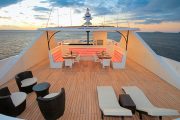DAY 1 – WEDNESDAY: Santa Cruz Island
This morning you will be transferred to the airport for your flight to the Galapagos Islands. Please note the pick-up time will usually be as early as 4:30 am (a boxed breakfast will be provided), as the airport is a one-hour drive away and you must allow for delays and check-in times. (Your tour leader will confirm this time with you at the Welcome Meeting on Day 1).
A US$20 per person transit card is payable on departure at Quito Airport and a US$100 per person national park entry fee is payable on arrival on the islands. Please have cash on hand for these transactions as using credit cards can be time consuming.
You will be met in the arrival hall of the airport (look out for ‘Queen Beatriz’ signs) by a transfer guide and transferred to our catamaran – ‘M.Y. Grand Queen Beatriz’, anchored on the other side of Santa Cruz Island. Our transfer guide will take you on an airport public bus for a short distance (5 minute drive) to where you board a public ferry across the Itabaca Channel. The ferry crossing takes only 7 minutes. (Please note that all public transportation costs are included). Once you reach Santa Cruz Island, a private bus you board a private bus for a 45-minute drive to Puerto Ayora, the main port of the island. Here, there will be two dinghies to transport you and your fellow travelers to the ‘MC. Queen Beatriz’. Once on board, cabins will be assigned and you get to meet our crew members and get to know your naturalist guide while enjoying a delicious lunch.
After lunch you embark on your first excursion and head into the highlands of Santa Cruz for a total change of scenery. Beginning at the coast you travel across Santa Cruz through the agricultural region and into the misty forests, where you can see the unique scalesia cloud forest and spend time observing giant tortoises in their natural habitat. Look out for the abundant bird life including different species of Darwin finches, woodpeckers, warbler finches and vermillion flycatchers.










 WhatsApp us
WhatsApp us